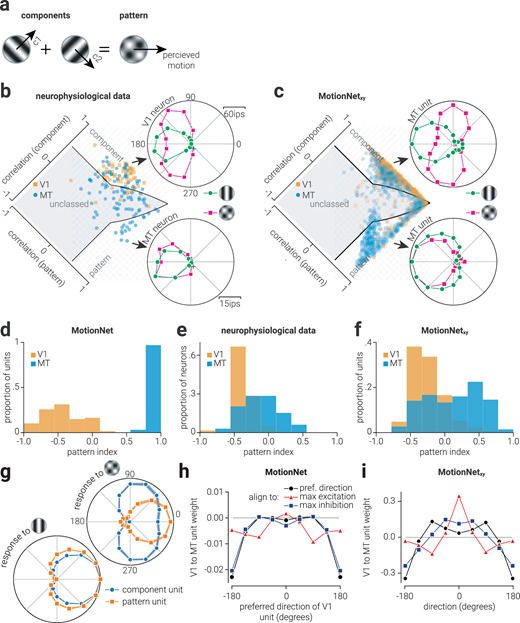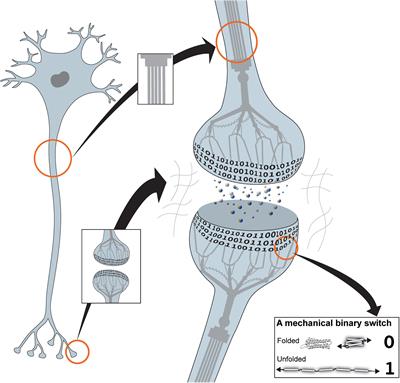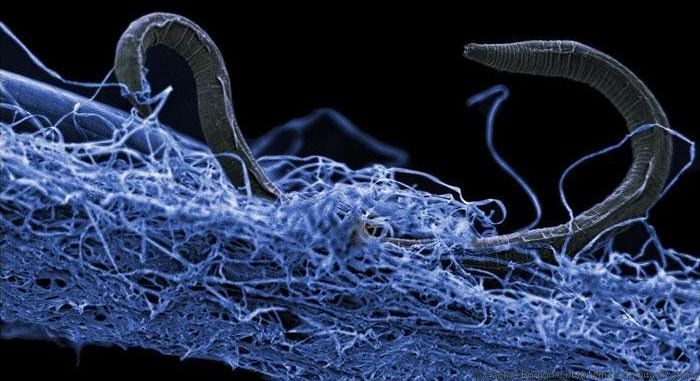
Category: biological – Page 185


The Mechanical Basis of Memory – the MeshCODE Theory
One of the major unsolved mysteries of biological science concerns the question of where and in what form information is stored in the brain. I propose that memory is stored in the brain in a mechanically encoded binary format written into the conformations of proteins found in the cell-extracellular matrix (ECM) adhesions that organise each and every synapse. The MeshCODE framework outlined here represents a unifying theory of data storage in animals, providing read-write storage of both dynamic and persistent information in a binary format. Mechanosensitive proteins that contain force-dependent switches can store information persistently, which can be written or updated using small changes in mechanical force. These mechanosensitive proteins, such as talin, scaffold each synapse, creating a meshwork of switches that together form a code, the so-called MeshCODE. Large signalling complexes assemble on these scaffolds as a function of the switch patterns and these complexes would both stabilise the patterns and coordinate synaptic regulators to dynamically tune synaptic activity. Synaptic transmission and action potential spike trains would operate the cytoskeletal machinery to write and update the synaptic MeshCODEs, thereby propagating this coding throughout the organism. Based on established biophysical principles, such a mechanical basis for memory would provide a physical location for data storage in the brain, with the binary patterns, encoded in the information-storing mechanosensitive molecules in the synaptic scaffolds, and the complexes that form on them, representing the physical location of engrams. Furthermore, the conversion and storage of sensory and temporal inputs into a binary format would constitute an addressable read-write memory system, supporting the view of the mind as an organic supercomputer.
I would like to propose here a unifying theory of rewritable data storage in animals. This theory is based around the realisation that mechanosensitive proteins, which contain force-dependent binary switches, can store information persistently in a binary format, with the information stored in each molecule able to be written and/or updated via small changes in mechanical force. The protein talin contains 13 of these switches (Yao et al., 2016; Goult et al., 2018; Wang et al., 2019), and, as I argue here, it is my assertion that talin is the memory molecule of animals. These mechanosensitive proteins scaffold each and every synapse (Kilinc, 2018; Lilja and Ivaska, 2018; Dourlen et al., 2019) and have been considered mainly structural. However, these synaptic scaffolds also represent a meshwork of binary switches that I propose form a code, the so-called MeshCODE.
Building Beauty with Biology
Help support our video productions http://www.patreon.com/scifri.
Produced by Luke Groskin.
Filmed by Christian Baker.
Music by Audio Network.
Additional Footage and Stills Provided by Joel Simon, Pond5, Shutterstock, Nic Symbios, Pit Schuni (C.C. BY 2.0)Okinawa Institute of Science and Technology (C.C. BY 2.0), Eleni Katafori, Bradely Smith, Loic Royer, Alexander Reben.
Inspired by the forces behind evolution, artist and tool designer Joel Simon programmed a network of computers to blend and “breed” together images over and over using users’ preferences as its guide. Although thousands of users, breeding millions of bizarre and beautiful images, Joel’s goal was more conceptual: He wanted to see if the system could evolve art and what types of forms might emerge from the process.

Chinese volunteers live in Lunar Palace 1 closed environment for 370 days
Volunteer students at Beihang University have reportedly lived in the Lunar Palace 1 biosphere environment for 370 days. Media outlets have reported that two groups of students took turns living in the biosphere over the course of 370 days, and required minimal supplies from the outside.
Many groups have tried building and living in biospheres over the years. The goal has always been to find out if it is possible to build a self-sustaining ecosystem that could be used on another planet. The most well-known was Biosphere 2—it was built in the Arizona desert and hosted people for two years, but ultimately failed in its goal to remain self-supporting. However, such efforts have led to a better understanding of how a real biosphere might work and how plants might be grown beyond Earth.
Over the past several years, the Chinese government has made it clear that they plan to send people to the moon in the coming years. They also plan to build a permanent colony there, to be shared with other countries, as soon as it is feasible. As part of that effort, they have been planning, building and testing biospheres since 2014. In 2017, they finished construction of the Lunar Palace 1 biosphere. Once set up and tested, four volunteers entered the facility and stayed for 110 days. Shortly thereafter, another group moved into the biosphere and stayed for 65 days—they were replaced immediately by another team who spent 200 days in the test environment. That team was then replaced by the first team, which spent an additional 105 days in the facility. Altogether, the two groups spent 370 consecutive days in the biosphere.

Dr. Ellen de Brabander — SVP, R&D, PepsiCo — The Future Of Food And Beverage Innovation
The Future Of Food And Beverage Innovation And Venturing — Dr. Ellen De Brabander, Ph.D. — Senior Vice President, R&D, PepsiCo
Dr. Ellen de Brabander, is Senior Vice President, Research and Development, at PepsiCo, the American multinational food, snack, and beverage company.
Dr. de Brabander has broad set of responsibilities at Pepsico and currently leads their global R&D functions including the Food Safety, Quality, Strategy & Portfolio Management, and their Sensory and Regulatory Affairs teams. She also leads their R&D Digital Transformation initiatives to transform the innovation process to bring new, innovative products to the market.
Dr. de Brabander is also a member of the board of governors at the New York Academy of Sciences and has served as Treasurer and board member International Life Science Institute of North America, an organization that brings together scientists from government, academia and industry to uphold the scientific integrity and objectivity of nutrition and food safety science in order to ethically improve food systems for the betterment of public health.
Additionally, Dr. de Brabander has also served as the interim and founding CEO of EIT Food (part of the EU’s European Institute of Innovation and Technology), which is a unique $1.5 Billion Euro innovation consortium with more than 50 partners from industry and academia, focused on transforming the food sector by designing and delivering unique and high impact research, innovation, business creation and education programs.

Humans are dirty. This NASA scientist helps prevent Mars from getting contaminated
How do you keep microbes from Earth from contaminating Mars? This NASA scientist, who worked on the Perseverance mission, explains: # CountdowntoMars # Mars2020.

Clocking the Movement of Electrons Inside an Atom – Down to a Millionth of a Billionth of a Second
Scientists get dramatically better resolution at X-ray free-electron lasers with a new technique.
Intense, ultrashort X-ray pulses from hard X-ray free-electron lasers (XFELs) can capture images of biological structures down to the atomic scale and shed light on the fastest processes in nature with a shutter speed of just one femtosecond, a millionth of a billionth of a second.
However, on these miniscule time scales, it is extremely difficult to synchronize the X-ray pulse that sparks a reaction in the sample with the follow-up pulse that observes the reaction. This problem, called timing jitter, is a major hurdle in performing these XFEL experiments with ever-better resolution.


Scientists Successfully “Wake” Microbes That Had Remained Dormant for 100 Million Years
Scientists have successfully managed to wake a series of microbes that had remained “asleep” for at least 100 million years. The microbes that existed during the dinosaurs’ time have shown traces of growth in the latest studies.
A team of scientists in the US and Japan says that these prehistoric microorganisms began to grow and divide despite having entered an energy-saving state when dinosaurs were still walking on Earth.
The microbes belonged to ten different bacteria groups and were recovered from sediments mined in 2010 at the bottom of the South Pacific Gyre, one of the most deserted parts of the ocean in terms of nutrients.